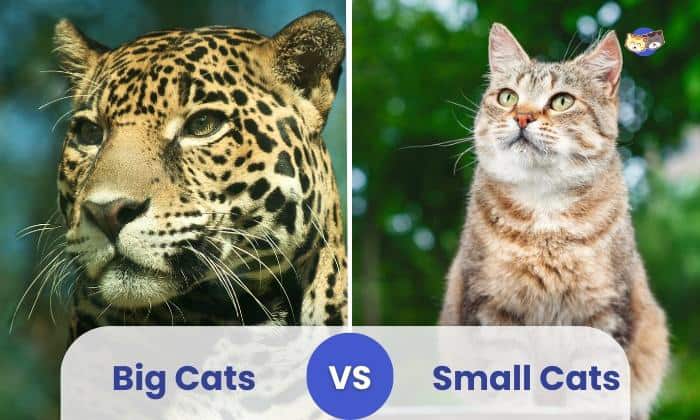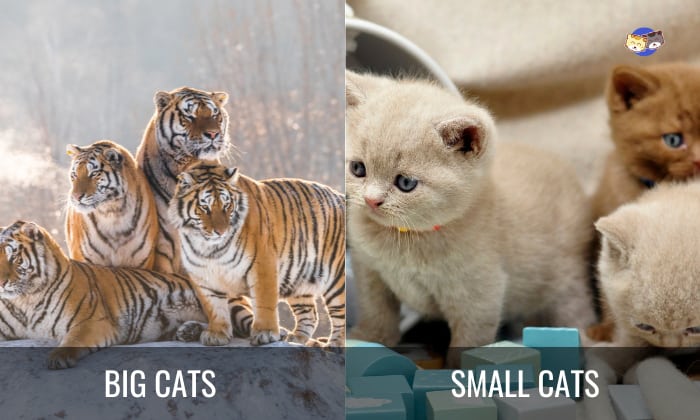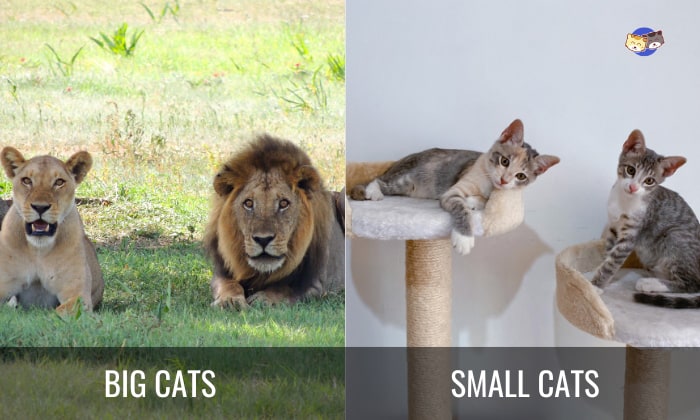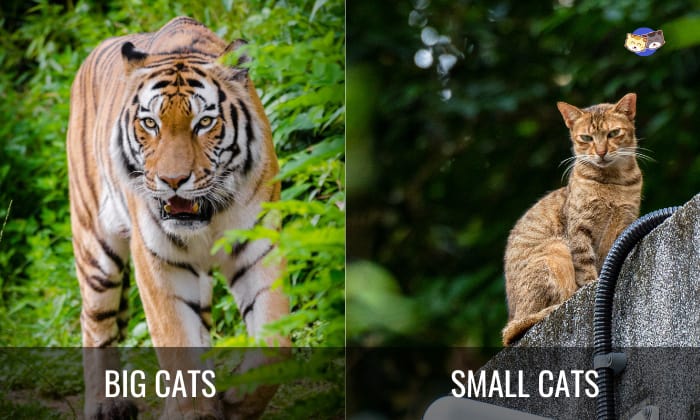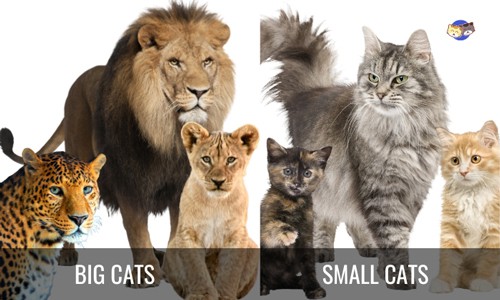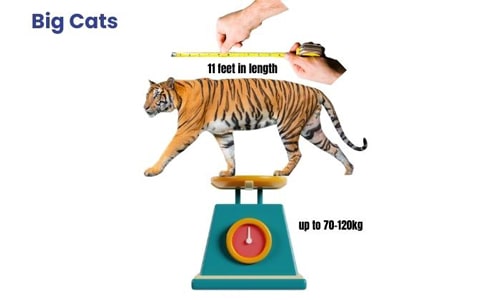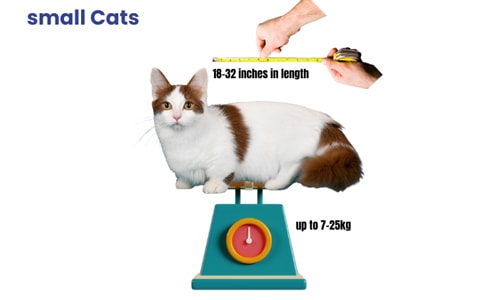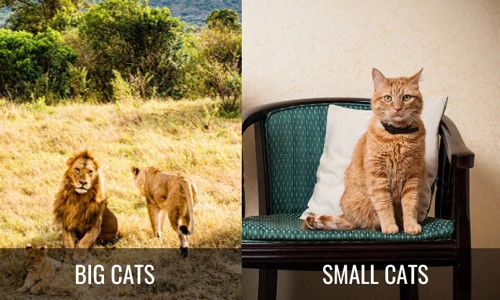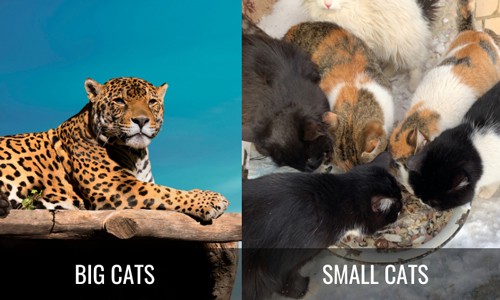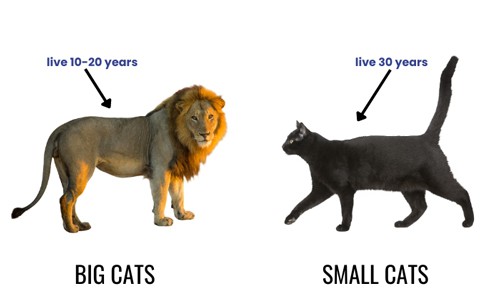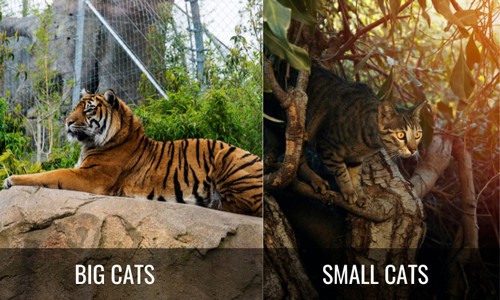Cats, members of the Felidae family are beloved and popular pets worldwide, known for their charm, independence, and unique personalities.
However, within the world of felines, there exists a captivating dichotomy between big cats vs small cats.
This article aims to explore the similarities and differences between these two cat categories across various aspects.
In that sense, readers will understand more about the nature of these magnificent creatures and will also learn what separates domestic cat from their wild counterparts.
To begin, let’s take a look at a comparison table summarizing the key points:
| Category | Big Cats | Small Cats |
| Size | Large (typically over 50 pounds) | Domesticated small felines can weigh around 15 pounds (or more) depending on breed. |
| Habitat | Varied, including forests, grasslands, deserts, and mountains | Varied, but mostly domestic |
| Species | Lion, Tiger, Cheetahs, etc. | Domestic Cat and some wild cats |
| Hunting Style | Apex Predator | Opportunistic |
| Vocalization | Roar | Purr |
| Social Behavior | Solitary | Social (domestic cats) |
| Lifespan | An average of 15-20 years depending on species and the environment | Can live up to 15 years and beyond (some even reach up to 25-30 years, still depending on what breed and its environment) |
| Conservation | Endangered | Not at Risk (domestic cats) |
Table of Contents
Overview
Within the fascinating world of the Felidae family, two distinct categories stand out—small cats vs big cats.
Big cat species, comprising majestic creatures like lions, tigers, and leopards, are renowned for their imposing size, unparalleled strength, and position as apex predators (which means they are at the top of the food chain and have no natural predators).
These regal felines roam diverse habitats, from dense forests to vast grasslands and lofty mountains, asserting their dominance with grace and power.
Contrastingly, the realm of small cats encompasses a diverse group, including domestic cats, ocelots, and other wildcats.
Their smaller stature grants them remarkable agility, allowing them to navigate various environments with ease.
Now, let us unveil the enchanting world of big and small felines, by delving into the intriguing similarities and differences that define these two distinct categories.
Similarities Between Big Cats and Small Cats
Despite their differences, large felines and small felines share some common characteristics.
- Both categories (small and big) belong to the Felidae family
- They possess retractable claws, acute hearing, and excellent night vision!
- Both have their instinctive nature to hunt prey. The only thing to note is that big cats are apex predators, (they hunt to survive), while some small cats prey on rather smaller animals (instinctual and sometimes for fun).
- Did you know that big cats in the wild also knead, just like the small lesser cats? Quite the fun fact, it is!
- Big and small cats also groom themselves meticulously, using their tongues to clean their fur and maintain their hygiene!
How Do Big Cats Differ From Small Cats?
1. Species and Breeds
Generally, the term “big cats” refers to specific species, such as lions, tigers, jaguars, leopards, and cheetahs.
Each of these species possesses unique physical characteristics, hunting techniques, and geographical distributions.
In contrast, small felines include a broader range of species, including the domestic cat (Felis catus) which comprises at least 45 breeds, as well as wildcats, margays, etc.
When referring to types of small cats, this includes various domestic cat breeds in general, such as Singapura, Burmese Cats, and more.
It’s worth noting that even the majestic Maine Coon, which holds the no. 1 title among the big cat breeds in the domestic feline world, still belongs to the relatively “small cat” category!
2. Size
The most apparent distinction lies in how big these two feline types are. Big felines can reach impressive proportions, weighing several hundred pounds and measuring up to 11 feet in length.
Small cats, on the other hand, are generally much smaller, weighing between 7-25 pounds and measuring 18-32 inches in length.
3. Vocalizations
Big cats, such as lions and tigers, have powerful and resonant vocalizations, limited to a few distinct sounds like roaring, chuffing, grunting, and growling.
Small cats, including domestic cats, are more vocal and versatile in their vocalizations, with meowing, purring, chirping, hissing, and caterwauling.
4. Habitat
Big cats primarily inhabit the wild, roaming vast territories in search of prey. They have specific natural habitats and are often restricted to particular regions around the world like savannas, tropical rainforests, grasslands, etc.
Conversely, tiny and lesser cats display greater adaptability, being able to thrive in various environments. While domestic cats are predominantly found in homes, other small cats, particularly small wildcats, can live in forests, deserts, and mountains.
5. Social Behavior
Except for lions who live in groups, most big cats are predominantly solitary animals, typically only socializing for mating purposes or when rearing their young. They establish and defend their territories, avoiding interactions with other individuals of the same species.
In contrast, small felines, particularly domestic ones, display more social behavior. They form bonds with humans and other cats, engaging in play, grooming, and communication.
6. Lifespan
Big cats in the wild typically live between 10-15 years (some may reach around 20 years in captivity).
While small cats, especially domestic cats, can live well into their late teens or even early twenties (some may reach 30 years!) with proper care and a suitable environment.
7. Conservation
One critical aspect where big and small felines differ significantly is their conservation status.
Big cats are often endangered or vulnerable due to habitat loss from deforestation, wildlife-conflict and illegal poaching for their valuable body parts.
Small cats, on the other hand, are generally not at risk on a global scale. However, some wild small cat species do face localized threats and conservation challenges.
Frequently Asked Questions
Are big cats more aggressive than small cats?
By nature, huge felines are known for their aggression primarily in the context of hunting and defending their territories. In contrast, small cats (domestic) may display aggression in certain situations but socially adapt through time.
Can small cats survive in the wild?
If referring to domesticated small cats, they may struggle to fend for themselves if released into the wild.
Conclusion
To summarize the things that we’ve covered about big cats vs small cats, with their unique qualities and traits, they provide a fascinating contrast!
Big cats are the top predators in the wild due to their impressive size and hunting prowess. On the other hand, small felines, especially domestic felines, have developed close relationships with people and have shown amazing adaptability.
No matter what size they are, our feline friends never fail to mesmerize us with their graceful movements, mystifying personalities, and enduring charm!

I am Amy Sawy, a Doctor of Veterinary Medicine (DVM) graduate from the University of Kansas. y husband, Dr. Plummer, and I own a veterinary clinic in Phillipsburg, Kansas. In addition to my professional background, I am a devoted pet owner myself, with a household that includes dogs, rodents, and most notably, cats – a total of five felines in my home.
In 2020, I joined an organization as a professional writer, leveraging my experience and collaborating with my team to deliver the most valuable information for your cat’s care.


